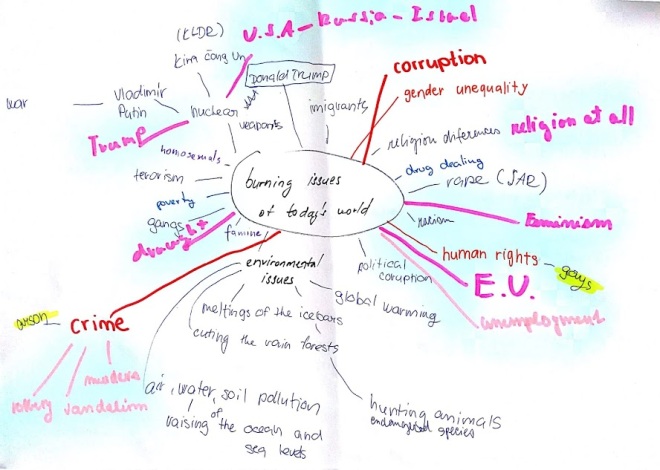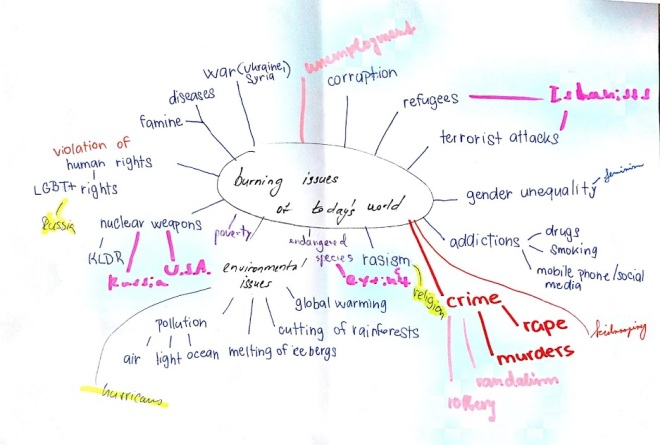In today’s post, I’d like to share an activity I did with my B2 students earlier today. The task was to make an imaginary podcast on the topic of the burning issues of today’s world. It all took about 60 minutes.
At first, I asked my students to brainstorm some ideas related to the topic. I didn’t pre-teach them any language at this stage – I only gave them a half-blank piece of paper with the central topic (burning issues of today’s world) in the center and one branch labeled environmental issues (a topic we had covered in detail in the previous lesson). Students worked in pairs brainstorming ideas for about 5 minutes. Then they sent the maps around the class and each pair always added something the previous pair hadn’t thought of. The pairs used colored markers (each pair a different color), so that we could trace back the authors of the contributions if need be. Each pair ended up with a nice, colorful mindmap full of interesting ideas.

This stage took about 25 minutes. Then I asked the students if they knew what a podcast was. Surprisingly, most of them didn’t. So I gave them the definition:
a radio programme that is stored in a digital form that you can download from the internet and play on a computer or on an MP3 player. It is usually part of a themed series.
I also gave them some of the characteristics of a podcast. I said that it often gives the impression of being unscripted. It sounds natural and spontaneous, and it’s often in the dialogic form. Depending on the topic, it can be pretty informal – it sometimes sounds like or is a chat between two friends or colleagues. I told them that basically anybody can create a podcast on a topic they are interested in.
So the mindmap was their guideline. This provided lots of space for spontaneity, but at the same time, the students had something to hold on to. They could talk about the issues in a totally random order and they could pick what they actually wanted to talk about and what to skip. I asked them to imagine that what they were saying was being recorded.
They did really well and I could see that they were soon fully absorbed in the discussion, occasionally peeking at the mindmap. After I stopped them (after about 10 minutes), I asked them if they were happy with the result and if they thought they could upload what they had ‘recorded’. They obviously said NO! in unison.
Anyway, as there was a reasonable number of students present (14), I told them that we were going to do a ‘collective podcast’ as well. In other words, we were all going to talk about the same topic but this time, it wasn’t to be in pairs but as a class together. I placed an imaginary microphone in the middle of the circle and we started chatting. Again, they could use their mind maps, or they could use brand new ideas if they wanted.
We finished 2 minutes before the bell rang. I was really happy with the way it all had gone. It was actually a classic debate but it was spiced up by the imaginary background. I mainly liked the fact that the students had generated all the language themselves. However, as this was a fairly challenging topic, I occasionally helped them with vocabulary or pronunciation. I winded up the lesson encouraging the students to find some interesting podcasts and I also reminded them that extensive listening practice could help them improve their English tremendously. I also nudged them to make their own podcasts. 🙂

Thank you for sharing this, Hana! Great idea! I look forward to trying it.
Interesting that many didn’t know what a podcast was. Maybe podcasts aren’t part of youth culture.
I think it would be interesting to actually have them record the podcast with a tool like Vocaroo. I’ve noticed that they will keep re-recording until they’re happy with the product, which gives them a lot of speaking practice.
LikeLiked by 1 person
Yeah. they could definitely do at home but there was no space in the actual lesson – it was simply too noisy for that. Thus the ‘fake’ podcast. :-))
LikeLike